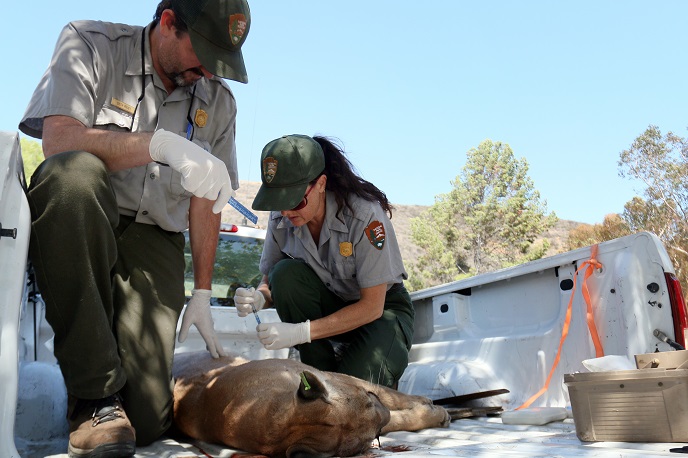|

National Park Service
Contact: Kate Kuykendall, 805-370-2343 THOUSAND OAKS, Calif. -- A young mountain lion was struck and killed by a vehicle on Interstate 5 near Castaic early Monday morning. Known as P-32, he is the only male known to have dispersed out of the Santa Monica Mountains and into the more contiguous habitat areas to the north.Prior to being struck on Interstate 5, he had managed to cross the 101 Freeway, State Route 23, Highway 118 and Highway 126 (see map). What had been a textbook case of successful dispersal all the way from the Santa Monica Mountains into Los Padres National Forest took an unfortunate turn when he headed east and attempted to cross one additional freeway.
"This case illustrates the challenges that mountain lions in this region face, particularly males," said Dr. Seth Riley, a wildlife ecologist with Santa Monica Mountains National Recreation Area. "P-32 conquered all kinds of freeways and highways to reach the Los Padres, but it was probably another dominant male that made him leave the area and attempt one last crossing, which obviously was not successful."
Still considered a juvenile, P-32 was approximately 21 months old and had first been ear-tagged by the National Park Service at four weeks of age. Based on GPS data from the animal's collar, he was likely hit by a vehicle between 4:00 and 6:00 a.m. Monday morning.
Since the study began in 2002, researchers are aware of only one male mountain lion born in the Santa Monica Mountains that has survived into adulthood, the famous Griffith Park mountain lion known as P-22. DNA evidence indicates he was born in the Santa Monica Mountains and thus had to cross both the 405 and 101 Freeways to make it to Griffith Park. Though he was able to flee the territory of more dominant adult males, his dispersal is not considered successful because he is now isolated in a small patch of habitat with no reproduction opportunities.
P-32 is the 12th mountain lion killed on a freeway or road since the study began. A proposed wildlife crossing on the 101 Freeway near Liberty Canyon Road would provide a connection between the genetically isolated population in the Santa Monica Mountains and the population to the north. The National Park Service has already documented multiple cases of first-order inbreeding south of the freeway.
Even with a wildlife crossing on the 101 Freeway, there is no way to completely eliminate the possibility of animals being struck by vehicles. The key, researchers say, is to ensure sufficient migration in both directions, but particularly from north to south, so that the population can survive in the long-term.
Although the cause of P-32's death was already known, biologists conducted a necropsy to evaluate the animal's condition and to take tissue samples that will show, among other things, whether the animal was exposed to rat poison. Other than the injuries sustained in the collision, P-32 appeared to be in good condition.
More detailed information about P-32's dispersal is available on the park's new urban wildlife blog, Gridlocked.
The National Park Service has been studying mountain lions in and around the Santa Monica Mountains since 2002 to determine how they survive in an increasingly fragmented and urbanized environment.
Santa Monica Mountains National Recreation Area (SMMNRA) is the largest urban national park in the country, encompassing more than 150,000 acres of mountains and coastline in Ventura and Los Angeles counties. A unit of the National Park Service, it comprises a seamless network of local, state and federal parks interwoven with private lands and communities. As one of only five Mediterranean ecosystems in the world, SMMNRA preserves the rich biological diversity of more than 450 animal species and 26 distinct plant communities. For more information, visit www.nps.gov/samo.
###
Tags:
puma news
|
Last updated: November 1, 2018
